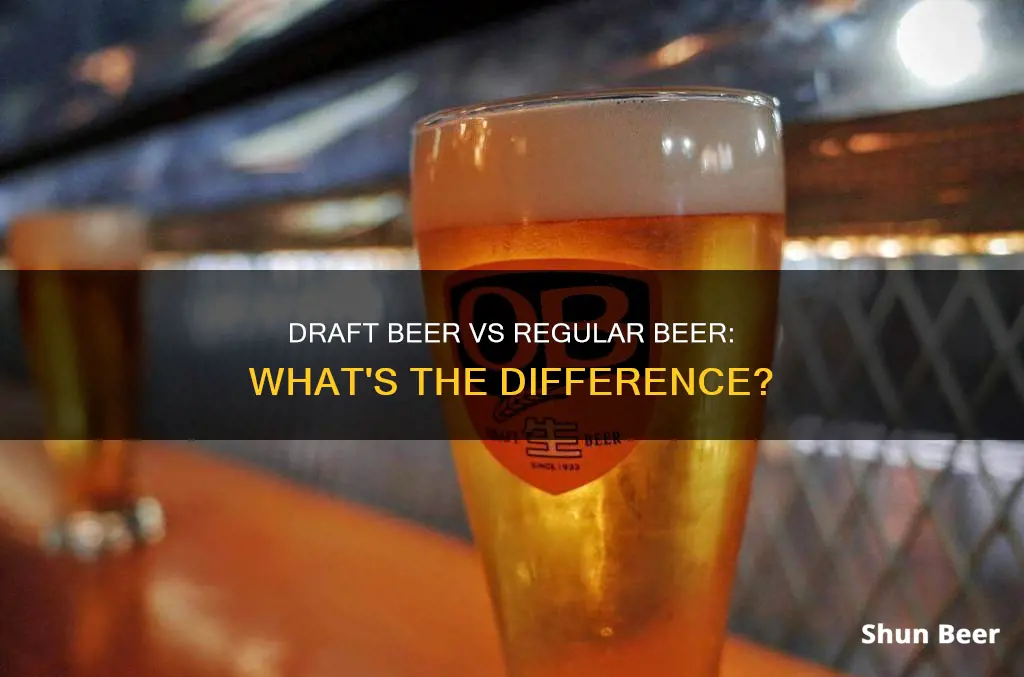
Beer is served in many different ways, but what's the difference between draft beer and regular beer? Draft beer, also known as draught beer, is served from a cask or keg and poured straight into a glass. It is often considered superior to canned or bottled beer as it is fresher, with more pronounced flavours and a smoother taste. However, bottled or canned beer may be preferable to some as it is stored under controlled conditions, protecting it from light and air. Ultimately, the choice between draft and regular beer comes down to personal taste preferences.
What You'll Learn

Beer on tap is fresher, brewed within the last few weeks
Beer on tap is fresher as it has been brewed within the last few weeks, meaning it has a smoother taste and more pronounced flavours from the hops and malt. The carbonation level of beer on tap is also different, which can affect the bitterness and mouthfeel of the beer.
The freshness of beer on tap is due to the fact that it is kept cold at a consistent temperature, protected from light, and served within a few weeks of being brewed. This is in contrast to bottled or canned beer, which can sit on shelves for weeks or even months and be exposed to temperature changes and light, causing the flavours to break down and fade.
The use of kegs for draft beer also has an impact on its freshness and flavour. Kegs are sealed containers that protect the beer from light and air, helping to preserve its freshness. Additionally, the pressure and temperature of draft beer can be easily customised, which affects the carbonation level and mouthfeel.
It is worth noting that the taste and quality of draft beer can be influenced by various factors, such as the cleanliness of the draft lines and the use of "beer gas" or air blenders by bars, which can alter the carbonation and flavour of the beer.
Overall, beer on tap is fresher and brewed more recently than regular bottled or canned beer, resulting in a smoother taste and more prominent flavours.
Beers vs Lagers: What's the Difference?
You may want to see also

Bottled or canned beer is better protected from light and air
Bottled or canned beer offers superior protection from light and air compared to draft beer. Beer is highly susceptible to degradation from light exposure, particularly UV rays, which can cause the formation of unpleasant sulfur compounds, resulting in a "skunky" aroma or "lightstruck" flavour. Brown bottles are the most effective at blocking light, followed by green and clear glass bottles. However, even brown bottles do not completely prevent light from entering, and over time, light can still cause beer to spoil.
Cans, on the other hand, are 100% light-tight, providing complete protection from light. Additionally, cans are superior at preventing oxygen exposure, which can cause oxidation and give the beer an off-putting smell akin to wet newspaper. The lining inside beer cans also ensures that the beverage never comes into direct contact with metal, dispelling the myth that canned beer has a metallic taste.
The seal of a well-packaged bottle also protects beer from oxygen exposure, although it may not be as effective as cans. Proper sealing is crucial to prevent oxidation and maintain the beer's freshness.
In summary, bottled or canned beer offers enhanced protection from light and air, with cans providing the most effective barrier against these elements.
Crunchy Coatings: Tempura vs Beer Batter
You may want to see also

Draft beer is less bitter and less carbonated
When it comes to the world of beer, there are numerous factors that can influence the taste, quality, and overall experience of this beloved beverage. One of the most debated topics among beer enthusiasts revolves around the differences between draft beer and regular, packaged beer. While personal preferences play a significant role in choosing between the two, understanding the unique characteristics of draft beer, especially its smoother and less bitter nature, can help beer lovers make more informed choices.
Draft beer, also known as beer on tap, is served directly from a keg into a glass or mug. This type of beer is often associated with freshness, as it is typically brewed within a few weeks of consumption. The direct transition from keg to glass ensures that the flavors of the hops and malt remain prominent, resulting in a smoother and less bitter taste compared to bottled or canned beer. The key to maintaining the optimal flavor of draft beer lies in the carbon dioxide pressure, beer storage temperature, and routine cleaning of the draft lines.
One of the critical aspects that set draft beer apart from its bottled or canned counterparts is the level of carbonation. Draft beer tends to have lower carbonation, which contributes to its smoother texture and mouthfeel. The constant pressure applied to the liquid in the keg results in a unique energy that bottled or canned beer might lack. However, it is worth noting that improper handling or equipment, such as the use of "beer gas" or air blenders by bars, can lead to excessive loss of carbonation in draft beer, deviating from the brewer's intended specifications.
The serving temperature of draft beer also plays a role in its bitterness and overall taste experience. Most distributors and bars maintain kegs at consistently cold temperatures, ensuring the beer remains fresh. This consistent temperature impacts the carbonation level and can enhance the smoothness of the beer. In contrast, bottled or canned beer may undergo temperature changes during storage and transportation, potentially affecting their flavor and carbonation levels.
It is important to recognize that the perception of bitterness in beer is influenced by carbonation levels. The process of pouring draft beer often results in knocking out a noticeable amount of carbon dioxide, which reduces the overall carbonation. This loss of carbon dioxide contributes to the reduced bitterness associated with draft beer. On the other hand, bottled beer is easier to gently pour, resulting in minimal carbon dioxide loss and, consequently, a higher level of carbonation retention.
In summary, draft beer's distinct characteristics, including lower carbonation, smoother mouthfeel, and optimal serving temperatures, contribute to its less bitter nature compared to regular, packaged beer. The freshness of draft beer, combined with the care and maintenance of the draft system, enhances its flavor and makes it a preferred choice for many beer enthusiasts. However, it is essential to remember that individual preferences vary, and the ultimate choice between draft and regular beer depends on the specific taste and sensory experience sought by the beer drinker.
Cerveza vs Beer: What's the Difference?
You may want to see also

Draft beer is stored at a consistent, cold temperature
One of the key differences between draft beer and bottled or canned beer is the storage temperature. Draft beer is stored at a consistent, cold temperature, whereas bottled and canned beers may be stored at variable temperatures and are often exposed to light, air, and temperature changes while sitting on store shelves.
Maintaining a consistent cold temperature for draft beer is important for several reasons. Firstly, it helps ensure the beer's freshness and preserves its flavour. Beer is highly susceptible to temperature changes, and when stored at higher temperatures, the flavours can start to break down and fade. By keeping draft beer consistently cold, the flavours of the hops and malt are better preserved, resulting in a smoother and more flavourful beer.
Secondly, the cold temperature slows down any microbiological growth that could occur in the draft lines or taps. Unfiltered beers, in particular, are susceptible to yeast growth, which can alter the flavour and quality of the beer. Regular cleaning of the draft lines is also crucial to prevent the build-up of any microbiological film that could impact the taste of the beer.
Additionally, the cold temperature affects the carbonation level of the beer. Carbon dioxide pressure and storage temperature influence the amount of carbonation in the beer. By maintaining a cold temperature, the carbonation remains stable, contributing to the desired level of carbonation and mouthfeel expected by the brewer.
The consistent, cold temperature of draft beer is made possible by storing the beer in kegs and casks, which are kept in controlled environments, such as walk-in coolers or refrigerators. This storage method helps ensure that the beer is served at the ideal temperature, enhancing its flavour and overall drinking experience.
Exploring Samuel Adams' Diverse Beer Flavors
You may want to see also

Draft beer is easier to pour and has less beer loss
Draft beer, also known as draught beer, is served from a cask or keg and poured directly into a glass or mug. On the other hand, regular beer is packaged in sealed bottles or cans. One of the main advantages of draft beer is that it is easier to pour and results in less beer wastage.
The use of "beer gas" or mixed gas by bars helps to smooth out the beer's flavour and makes it less carbonated, which in turn makes it easier to pour. This reduces beer loss due to sloppy bartending, as the carbonation levels in bottled or canned beer can lead to more foaming and spillage during pouring.
Additionally, draft beer is stored in kegs that are consistently kept cold, ensuring a fresh and optimally flavoured beverage. The temperature and pressure of draft beer can be easily customized with modern draft setups, allowing for a slight textural difference that makes it smoother and less bitter than its bottled or canned counterparts.
The serving method of draft beer also contributes to its ease of pouring. When poured from a tap, a noticeable amount of carbon dioxide is released, reducing the carbonation level and resulting in a smoother mouthfeel. This loss of carbon dioxide during pouring is less significant with bottled beer, as it is easier to gently pour and control the amount of carbonation retained.
While draft beer offers advantages in terms of ease of pouring and reduced beer loss, it is important to consider the potential drawbacks. Negligence in cleaning draft lines and taps can lead to microbiological growth and flavour changes. Therefore, proper care and maintenance of draft beer systems are crucial to ensure a positive drinking experience.
A Unique Blend: Mixing Four Distinct Beers Together
You may want to see also
Frequently asked questions
Draft beer is served from a tap, while regular beer is served from a bottle.
Yes, draft beer is typically fresher and has a more complex taste and aroma than regular beer. However, regular bottled beer is usually cleaner and more sterile than draft beer.
Regular bottled beer is more convenient for consumers as it is easy to transport and store. On the other hand, draft beer may be preferred by bars and restaurants due to its lower cost and reduced environmental impact from packaging.







